
Potomac Marble was used for columns in the US House of Representatives when Benjamin Latrobe rebuilt the Capitol after it was burned in 1814
Source: Sue Waters, National Statuary Hall Collection in United States Capitol

Potomac Marble was used for columns in the US House of Representatives when Benjamin Latrobe rebuilt the Capitol after it was burned in 1814
Source: Sue Waters, National Statuary Hall Collection in United States Capitol
When Virginia was part of the supercontinent Rodinia and south of the Equator, limestone and dolostone (with magnesium as well as calcium) accumulated on a continental shelf on the edge of the Iapetus Ocean.
The magnesium-rich dolostone in Loudoun County is known today as the Tomstown Formation, and is exposed on the surface east of Furnace Mountain. Crystal Grottoes, the only commercial cave in Maryland, is located in the Tomstown Formation. Hokie Stone used for building exteriors at Virginia Tech is a dolostone, from the younger Chepultepec Formation.3
"Crystal Grottoes, Washington County," Maryland Geological Survey, http://www.mgs.md.gov/geology/caves/crystal_grottoes.html' "All About Hokie Stone," Virginia Tech, https://www.vt.edu/about/traditions/hokie-stone.html (last checked August 16, 2023)
The dolostone known as the Tomstown Formation was deposited on top of the Antietam Quartzite as sea level rose higher. Below the Antietam Quartzite was the billion year old Grenville basement, formed when tectonic plates had crashed together to create the supercontinet Rodinia.
The Tomstown Formation dates to the Cambrian Period. What is now bedrock in Loudoun County was created as plant skeletons descended to the bottom of the Iaptus Ocean around 513 million years ago. The formation is less than 200' thick in Loudoun County, but is 1,000 feet or more in thickness in the Shenandoah Valley.
The calcium-rich limestone in Loudoun County is known as the Frederick Limestone. It is relatively younger, dating to roughly 485 million years ago.
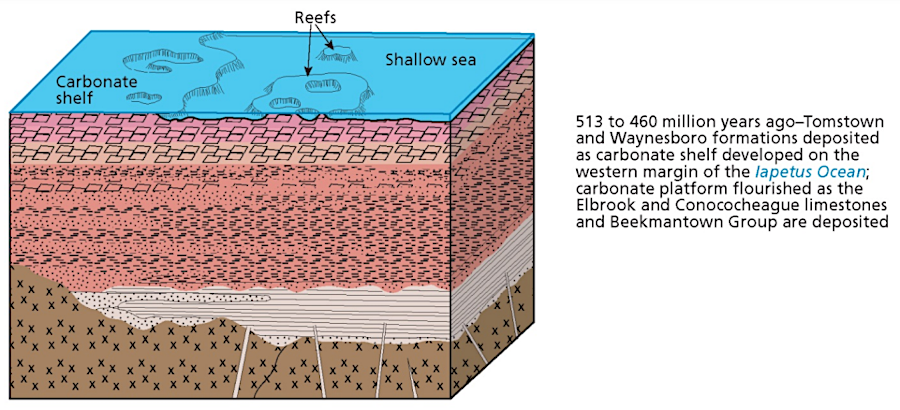
the limestone formations in Loudoun County consist of plant skeletons that fell to the bottom of the Iapetus Ocean half a billion years ago
Source: National Park Service, Geologic Resources Inventory Report (p,41)
During the Taconic Orogeny, one or more island arc terranes collided with the continental shelf. The sedimentary deposits were cracked and shoved inland, in some cases with broken slices stacked on top of each other like plates stored in a cabinet. The same process may have affected what is now Northern Virginia during the neo-Acadian Orogeny. During the Allghenian Orogeny, the collision with the tectonic plate which included Africa cracked the edge of the Grenville basement.
About 250 million years ago, a slice of that basement rock was shoved roughly 40 miles westward. That broken off edge of the Grenville basement, known today as the Blue Ridge, cracked up through the old Iapetus Ocean seafoor deposits. Erosion has removed that part of the sedimentry formations that were once directly above the center of the Blue Ridge. As a result, some of the Tomstown Formation is now found on the eastern side of the Blue Ridge (including north of Leesburg) and some on the western side (including Bolivar Heights in Harpers Ferry).3
"Geologic Resources Inventory Report," Shenandoah National Park, p.39, https://irma.nps.gov/DataStore/DownloadFile/654635; "Bedrock Geologic Map of Shenandoah National Park," National Park Service, hhttps://irma.nps.gov/DataStore/Reference/Profile/2251656;Scott Southworth, William C. Burton, J. Stephen Schindler, Albert J. Froelich, "Geologic Map of Loudoun County, Virginia" pamphlet to accompany Geologic Investigations Series Map I-2553, US Geological Survey, 2006, p.22, https://ngmdb.usgs.gov/Prodesc/proddesc_81090.htm (last checked August 17, 2023)
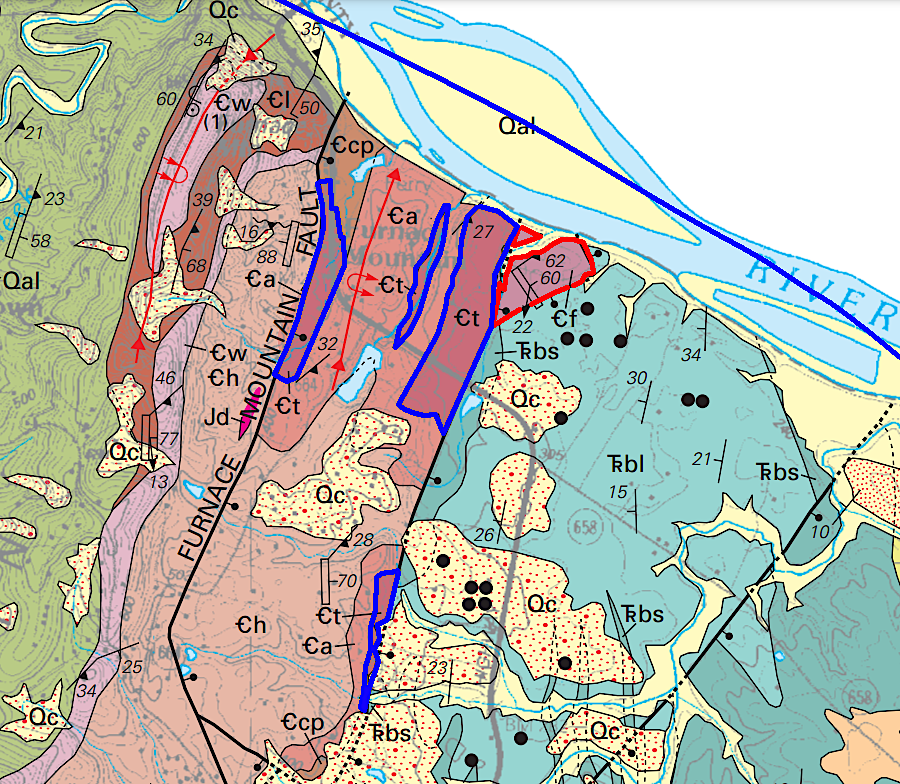
Tomstown Formation dolostone (red polygons) and Frederick Limestone (red polygons) from the Cambrian era are exposed east of Furnace Mountain in the northern edge of Loudoun County
Source: US Geological Survey (USGS), Geologic Map of Loudoun County, Virginia (Revised March 2007)
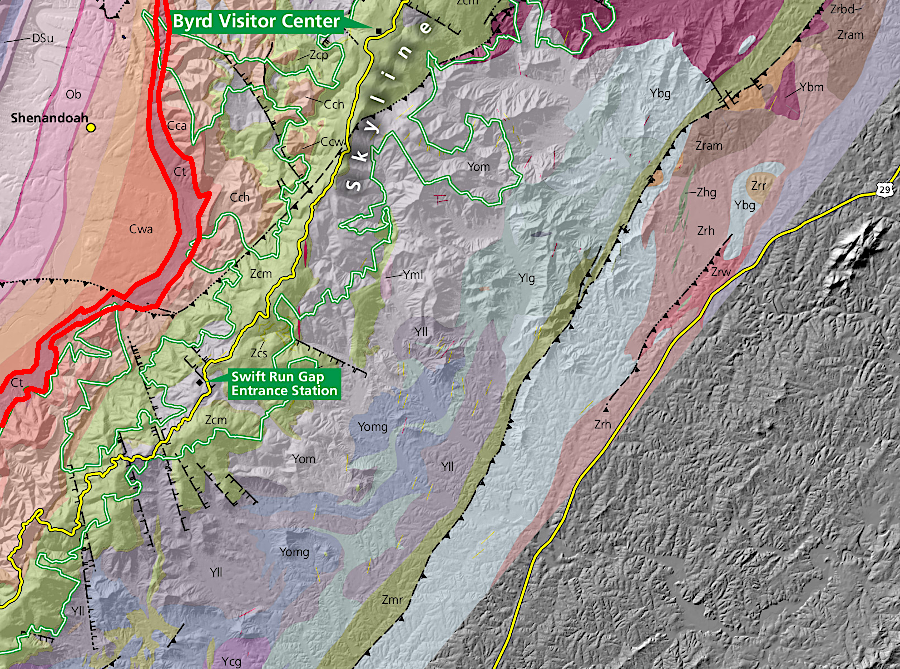
the Tomstown Formation (red polygon) is thicker on the western side of the Blue Ridge
Source: National Park Service, Bedrock Geologic Map of Shenandoah National Park
There is actual marble in Loudoun County, with dolomite and limestone minerals metamorphosed into a tighter crystalline structure from heat and pressure. Some of the marble is in the Swift Run Formation, which was heated by the Cataoctin basalt 550-570 million years ago and then deeply buried. The marble appears in discontinuous layers as narrow as 3' thick and up to 400' thick.
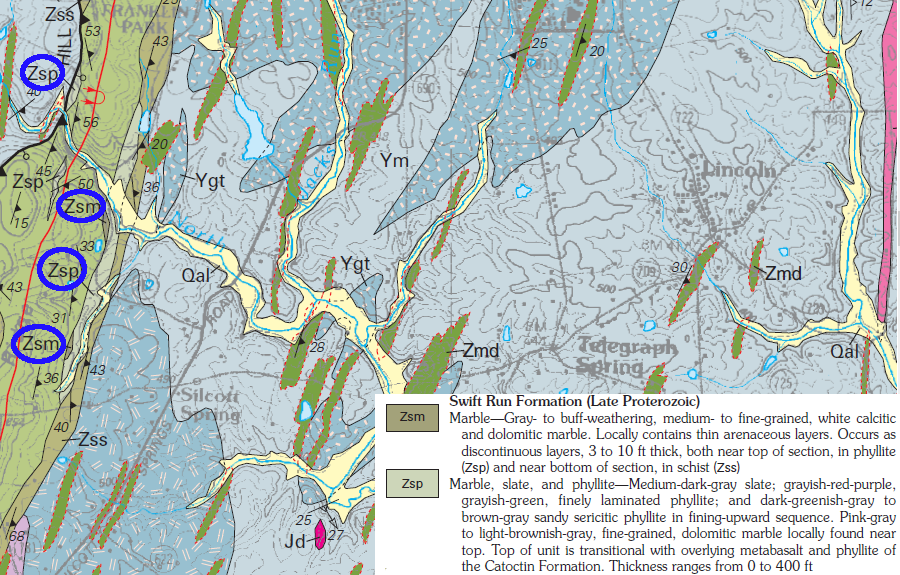
Precambrian deposits of limestone in the Swift Run Formation have been metamorphosed into marble (circled in blue)
Source: US Geological Survey (USGS), Geologic Map of Loudoun County, Virginia
During the late Jurassic Period and early Triassic Period, as Pangea split up and a rift valley (Culpeper Basin) began to form east of the Blue Ridge, old limestone and dolostone sediments were eroded from the bedrock. Floods and other high-energy erosion events, such as major storms, broke off fragments and carried those carbonates a short distance downstream. The stone was depositd in alluvial fans at the mouths of rivers flowing east into freshwater lakes and/or in marine bays in the rift valley, as Pangea split up.
Some cobbles traveled enough distance to develop rounded edges. Most chunks of limestone/dolostone still retained their sharp edges when the fragments accumulated in the alluvial fans.
Over time, the Triassic Period sediments were compacted and cemented together to create a solid breccia. The heat and pressure was high enough to create solid rock formations such as the Leesburg Member of the Balls Bluff Siltstone, but not high enough to metamorphose the carbonates into marble. The Leesburg Member is 3,500 feet thick, indicating that erosion and redeposition of older (Cambrian Period) dolostone/limestone continued for a significant period of time.
In weak spots of the thinning crust, lava flowed up towards the surface. The dikes and sheets of molten rock altered the sandstone, mudstone, and limestone/dolostone cobbles into hornfels and marble. In some places, the heat of the lava was sufficient to metamorphose sediments one mile wide and 700 feet thick.3 Scott Southworth, William C. Burton, J. Stephen Schindler, Albert J. Froelich, "Geologic Map of Loudoun County, Virginia" pamphlet to accompany Geologic Investigations Series Map I-2553, US Geological Survey, 2006, p.22, https://ngmdb.usgs.gov/Prodesc/proddesc_81090.htm; "Cambrian Period—541 to 485.4 MYA," National Park Service, https://www.nps.gov/articles/000/cambrian-period.htm;
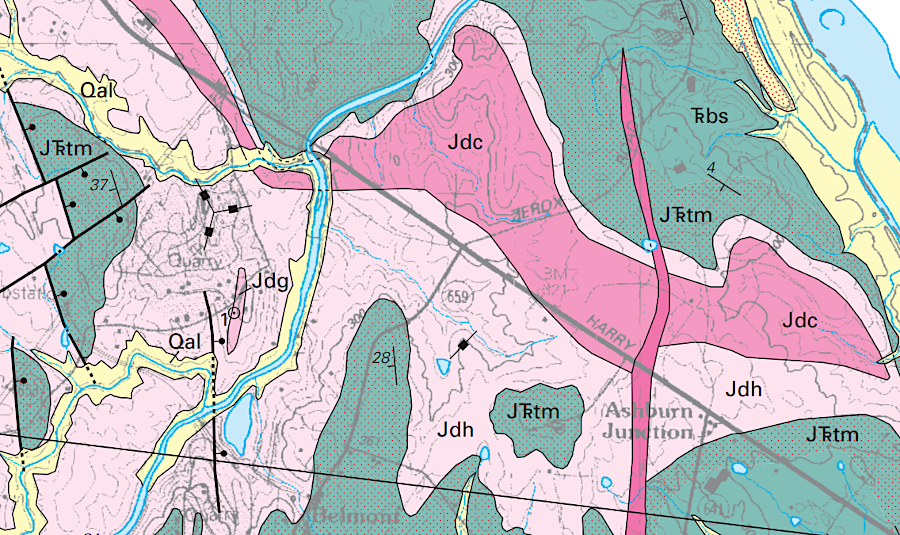
Jurassic/Triassic dikes and sills (red and pink) metamorphosed calcium-rich cobbles into marble, in places coded as "JTrm" with reddish spots on the geologic map
Source: US Geological Survey (USGS), Geologic Map of Loudoun County, Virginia
Layers of limestone and dolomite originally deposited on a flat ocean bottom have been uplifted, broken, transported, redeposited, and in some cases metamorphosed. Starting in the 1700's, the calcium-rich deposits were recognized as a valuable resource for agriculural fertilizer.
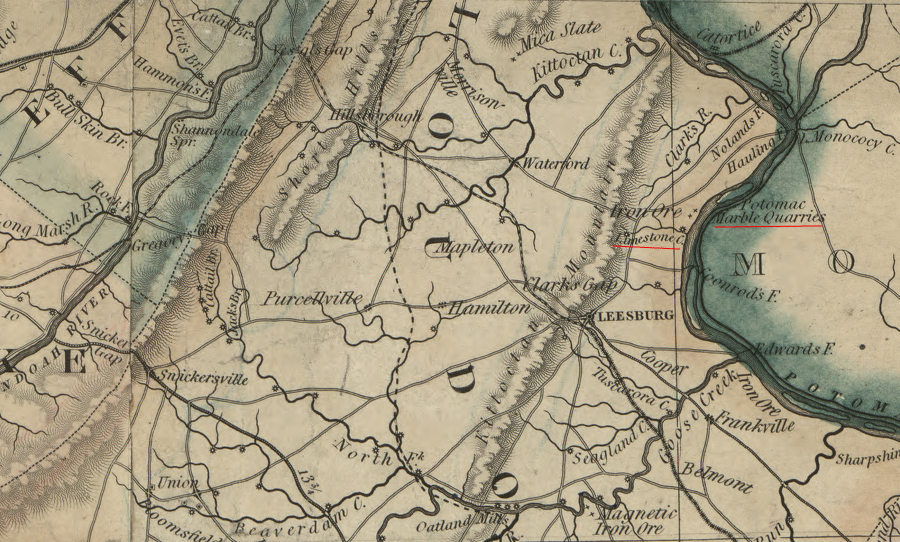
the limestone deposits in Loudoun County were mined primarily for agricultural lime prior to the Civil War
Source: Library of Congress, A map of the state of Virginia, constructed in conformity to law from the late surveys authorized by the legislature and other original and authentic documents (1859)
A 50' thick layer of breccia known as "Potomac Marble" was mined near Goose Creek between 1798-1949.
By the time Thomas Jefferson was elected president, was being excavated for agricultural fertilizer and for building stomne. Primary quarries were near Goose Creek in Loudoun County and next to the Chesapeake and Ohio Canal in Montgomery County, Maryland. Despite the name, the rock was not limestone metamorphosed into marble. Instead, cobbles and pebble of broken rock were encased like marbles in a matrix of limestone.
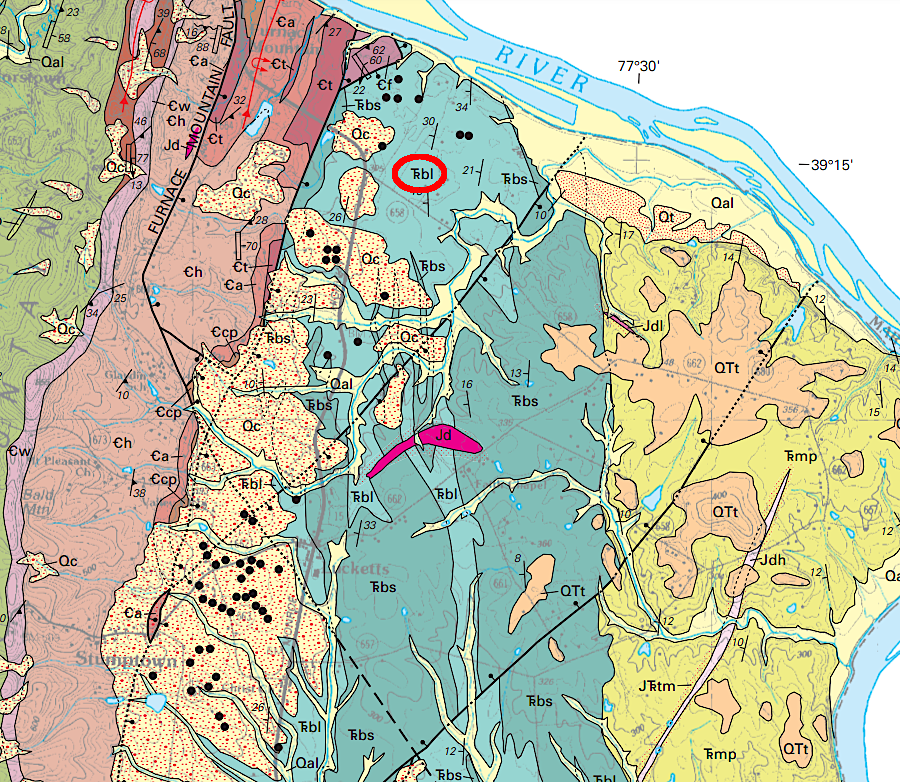
the older dolostone/limestone was redeposited in the Triassic Period to form the limestone-rich Leesburg Member ("Trbl")
Source: US Geological Survey (USGS), Geologic Map of Loudoun County, Virginia
The Potomac Marble was crushed, burned to produce lime, and spread on the fields of Oatlands and other plantations to enhance productivity of the soil. The Virginia Marble Company operated the quarries after the Civil War, and it became one of the largest employers of African-American men in the county.
That Loudoun County marble was used to produce the Confederate memorial erected in Little Washington, Rappahannock County and the 1898 Confederate Heroes Monument in Page County. (A second marble monument installed later in downtown Luray, and two other Confederate soldier memorials in Lunenburg and Spotsylvania counties, were sculpted in Georgia.) The Virginia Marble Company produced terrazzo (marble chips) until 1949 at Goose Creek.4
Eugene Scheel, "History of Loudoun's Limestone Overlay District," The History of Loudoun County, Virginia, https://www.loudounhistory.org/history/limestone-overlay-district/; Thomas R. Seabrook, Tributes to the Past, Present, and Future: Confederate Memorialization in Virginia, 1914-1919, master's degree at Virginia Tech, April 30, 2015, p.29, https://vtechworks.lib.vt.edu/bitstream/handle/10919/52895/Seabrook_TR_T_2015.pdf; Harry W. Webb, Palmer C. Sweet, "Interesting Uses of Stone in Virginia - Part I,", Virginia Minerals, Virginia Department of Mines, Minerals and Energy, Volume 38 Number 4 (November 1992), p.31, https://www.dmme.virginia.gov/commercedocs/VAMIN_VOL38_NO04.PDF; "Confederate Heroes Monument," Historical Marker Database, November 2, 2008, http://www.hmdb.org/marker.asp?marker=16457; Deborah A. Lee, "An Introduction to Loudoun County's African American Communities," Friends of the Thomas Balch Library, 2004, p.8, https://static1.squarespace.com/static/559ec31fe4b0550458945194/t/56833f10dc5cb44ad782a414/1451441936950/An+Introduction+to+Louodoun%27s+African+American+Communities.pdf (last checked May 12, 2017)
The largest Virginia deposits of limestone and dolomite are in the Valley and Ridge physiographic province. Limestone outcrops are readily visible along Interstate 81, which crosses that province from the Shenandoah Valley in the north to the Tennessee border.
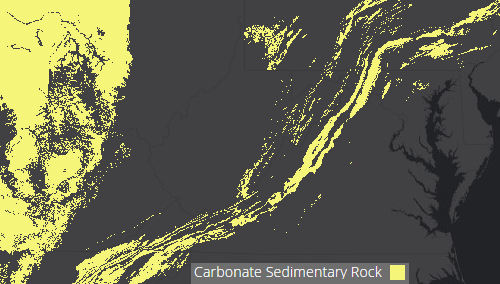
nearly all limestone exposed at the surface in Virginia today was deposited in the Iapetus Ocean, before the addition of the land between the Blue Ridge and Atlantic Ocean
Source: ESRI, Ecological Tapestry of the World
Roughly 500 million years ago, the region was located at the edge of the supercontinent Rodinia. It was underwater, near the shoreline of a part of the Iapetus Ocean known as the Sauk Sea. At the time, "Virginia" was located south of the Equator, and coral reefs grew in the warm waters. Zooplankton and larger forms of life protected by shells thrived in the Sauk Sea. When they died and sank to the bottom, deposits of limestone (and magnesium-rich dolomite) gradually accumulated.
Tectonic forces moved chunks of continental crust and closed the Iapetus Ocean. Terranes from island arcs were pushed against the edge of Virginia in the Taconic, Acadian, and Alleghenian orogenies. The island arcs widened the crust over the last 400 million years to create the Piedmont and Coastal Plain physiographic provinces, but the orogenies also narrowed the old continent. The sediments on the floor of the Sauk Sea were cracked, thrust slid up ramps of softer shales, and stacked on top of other layers like pancakes.
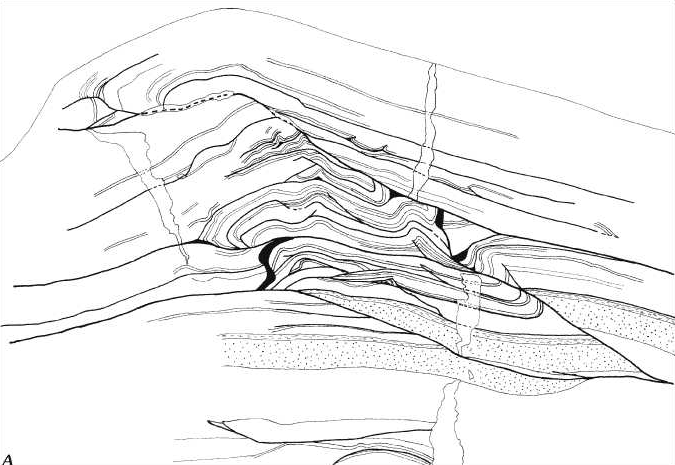
tectonic forces during orogenies cracked sedimentary layers at weak zones and slid layers of limestone on top on one another, like a stack of pancakes
Source: US Geological Survey (USGS), Lateral Ramps in the Folded Appalachians and in Overthrust Belts Worldwide - A Fundamental Element of Thrust-Belt Architecture (Figure 4A)
A slice of the igneous bedrock, the granites and gneisses deep underneath the Sauk Sea sediments, was a slice broken off the edge of the continent. That crust was shoved 40 miles to the west, emplacing the Blue Ridge at least partially on top of the much younger limestone/dolomite layers. The Blue Ridge fault marks the western edge of the slice of igneous bedrock that was moved westward.
Carbonate layers that were once at the bottom of the Sauk Sea, on the edge of Rodinia, are now west of the Blue Ridge and far from the modern shoreline. Those limestone/dolomite sediments are the common bedrock in the Shenandoah Valley, in the Roanoke Valley, in the New River Valley, and in the valleys of the Tennessee River's upper tributaries (Holston, Clinch, and Powell rivers).
Today, limestone is being deposited again on the edge of the continent. The Iapetus Ocean, once on the edge of Virginia, was eliminated by the formation of the supercontinent Pangea. Like Rodinia, Pangea has cracked up and today the Atlantic Ocean is on the edge of Virginia. Calcium-rich shells of dead zooplankton are slowly accumulating on the bottom of the Atlantic Ocean, creating new limestone formations in a process comparable to how the bedrock of the Shenandoah Valley formed 300-500 million years ago.

for over the last 150 million years, new limestone formations have been deposited at the bottom of the Atlantic Ocean on the passive continental margin
Source: National Park Service, Mature Ocean Basin Diagram
Some of large limestone quarries that excavate the limestone crush it to produce agricultural lime, but most quarries sell the stone for construction. The railroads haul limestone gravel east through the Blue Ridge to support the beds of the tracks. East of Thoroughfare Gap, railroad tracks are placed on top of distinctly-colored grey rocks that appear out of place in the iron-rich bedrock of the Culpeper Basin.
As far back as the mid-1700's, Shenandoah Valley residents used limestone blocks to build fortified houses that offered protection against Shawnee, Seneca, and Cherokee raids. The standard architecture at Virginia Tech relies upon quarries near Blacksburg that supply "Hokie Stone" from sediments deposited 500 million years ago. Courthouses and other public buildings west of the Blue Ridge are often made of limestone.
One major deposit of limestone is exposed on the surface near Leesburg, east of the Blue Ridge in Loudoun County. Limestone conglomerate at Raspberry Falls/Leesburg ("Calico marble" or "Potomac marble") is the Leesburg Member of the Balls Bluff Siltstone. The limestone cobbles in the conglomerate were deposited originally in the Sauk Sea, in sediments now exposed in Frederick County Maryland as the Frederick Limestone and Tomstown Formation. During the Triassic Period, carbonate clasts were eroded in storms, carried downstream in flooded river channels, and deposited in debris-flow deposits on alluvial fans in the Culpeper Basin.5
Scott Southworth, William C. Burton, J. Stephen Schindler, Albert J. Froelich, "Geologic Map of Loudoun County, Virginia" pamphlet to accompany
Geologic Investigations Series Map I-2553, US Geological Survey, 2006, p.26, https://pubs.usgs.gov/imap/2553/ (last checked May 12, 2017)
The "Potomac marble" is actually a conglomerate, not metamorphosed limestone. When the Capitol in Washington, DC was rebuilt after being burned by British troops in 1814, the "marble" was quarried in Maryland and used by Benjamin Latrobe for the columns in the Senate Chamber. Those columns are sill visible in what is now Statuary Hall.

when the US Capitol was rebuilt afer 1814, Potomac Marble was used for the columns in the Senate Chamber
Source: National Gallery of Art, The House of Representatives (by Sanmuel F. B. Morse, 1822)
Conglomerate mined near Leesburg was processed into agricultural lime. One historic quarry is located near the modern pond in Olde Isaak Walton Park. Others are located on Lime Kiln Road, between US 15 and Snickersville Turnpike.6
Paul Kreingold, "Benjamin Latrobe’s Potomac Marble Quarries," C&O Canal Association, December 19, 2019, http://candocanal.org/histdocs/potomac-marble.html; "National Statuary Hall," Architect of the Capitol, https://www.aoc.gov/capitol-buildings/national-statuary-hall (last checked February 6, 2020)
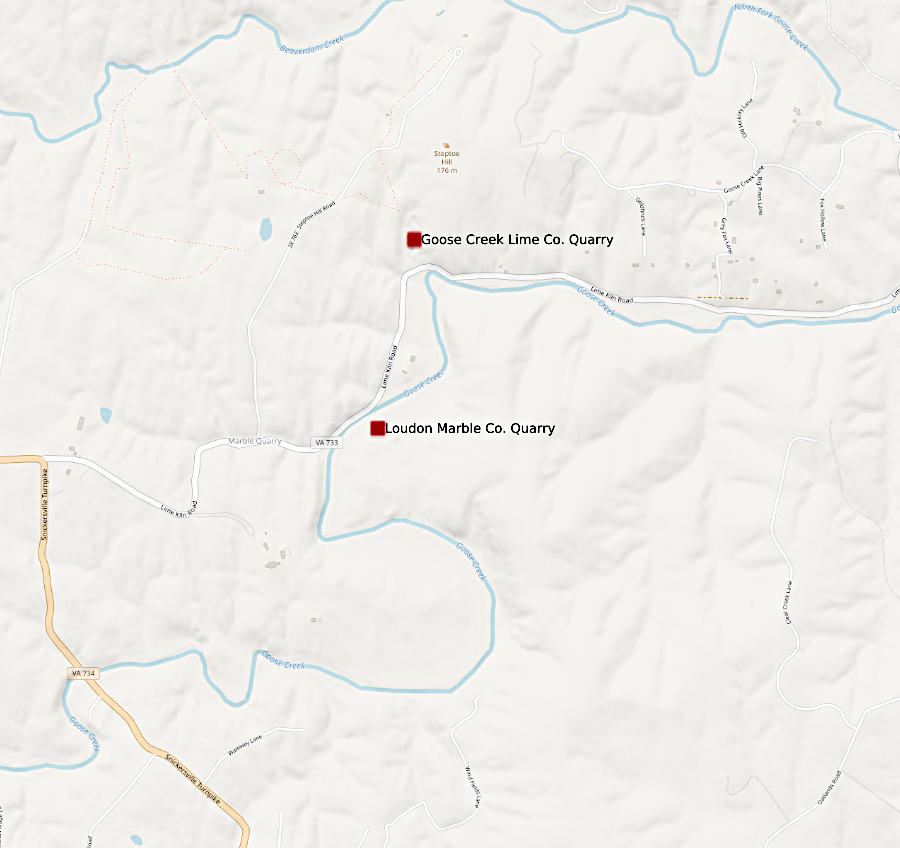
Lime Kiln Road in Loudoun County reveals the geologically-based industry there
Source: US Geological Survey (USGS), Mineral Resources Data System
The only known natural caves in Virginia located east of the Blue Ridge are in the Leesburg Member, north of Leesburg. There are also sinkholes in Loudoun County east of Route 15, and the local geology is reflected in the name of the stream "Limestone Branch."
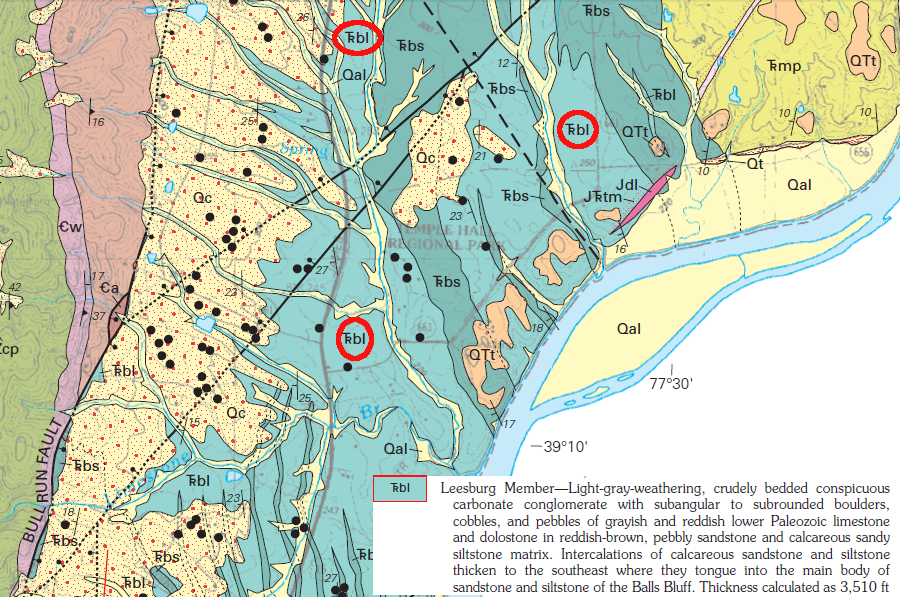
the only natural caves in Virginia east of the Blue Ridge are in the conglomerate known as the Leesburg Member (circled in red), which also produced sinkholes at Temple Hall Regional Park
Source: US Geological Survey (USGS), Geologic Map of Loudoun County, Virginia
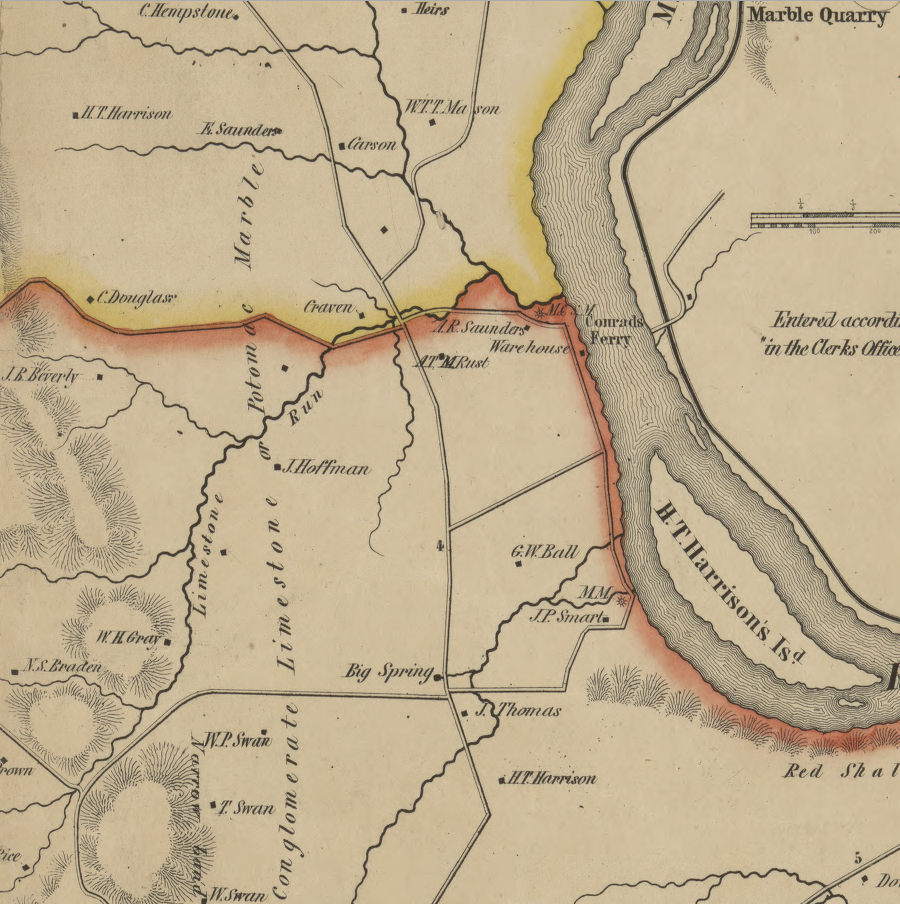
Limestone Run in Loudoun County is now called Limestone Branch
Source: Library of Congress, Map of Loudoun County, Virginia (by Yardley Taylor, 1854)
There is also a Limestone Creek that flows into the Rivanna River in Albemarle County, five miles southeast of Monticello. Thomas Jefferson purchased in 1771 and 1773 four acres of "limestone land" (Everona Formation) for production of mortar, which was needed to build his mansion house. The lime-based mortar was used between the bricks to cement them into weight-bearing walls, and to coat the columns on the West Front that appear on the nickel coin.
Lime produced from the Everona Member of the True Blue Formation was also used to build the University of Virginia. The layer of limestone is 1,000' thick at Limestone Creek, in the trough of the Everona Syncline.7
Bob Self, "Columns Return to 'Rendered' Appearance," Monticello, May 23, 2013, https://www.monticello.org/site/blog-and-community/posts/columns-return-%E2%80%98rendered%E2%80%99-appearance; "Limestone Land," Monticello, https://www.monticello.org/site/research-and-collections/limestone-land#footnote7_yo7ifkp; Wilbur A. Nelson, "Geology and Mineral Resources of Albemarle County," Virginia Division of Geology and Mineral Resources, Bulletin 77, 1962, pp.61-62, p.70, https://www.dmme.virginia.gov/commercedocs/BUL_77.pdf; Avery Ala Drake, Jr., Louis Pavlides, "Stratigraphic Notes, 1993," U.S. Geological Survey Bulletin 2076, 1994, pp.B4-B6, https://pubs.usgs.gov/bul/2076/report.pdf (last checked February 6, 2020)
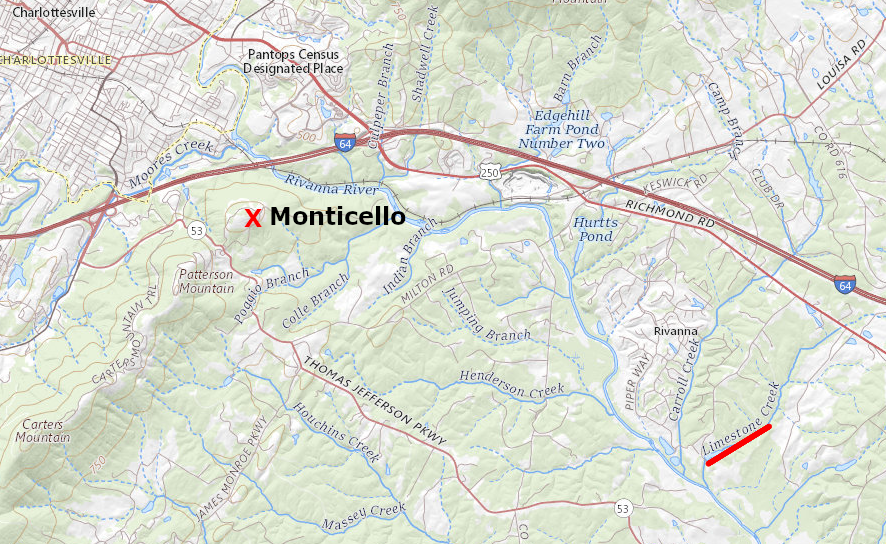
Jefferson bought a quarry on Limestone Creek, to obtaine lime from the Everona Member for building Monticello
Source: US Geological Survey (USGS), The National Map
Orange County has identified the Everona Limestone as "one of the County’s greatest groundwater assets," and mapped it as part of the Groundwater Protection Zone.8
"2013 Orange County Comprehensive Plan," Orange County, 2013, p.48, p.50, p.81, http://orangecountyva.gov/DocumentCenter/View/1442/2013-Comprehensive-Plan---BOS-amended-5-8-18?bidId=; "Orange County's Rapidan River reliance," Orange County Review, July 2, 2020, https://dailyprogress.com/community/orangenews/news/orange-countys-rapidan-river-reliance/article_8bfa6134-e353-11e2-b92a-0019bb30f31a.html (last checked December 5, 2020)

the Orange County Comprehensive Plan identifies the Everona Limestone, in the trough between two slices of the Blue Ridge, as a potential source of groundwater
Source: Orange County, 2013 Comprehensive Plan (p.81)
Limestone in Virginia is crushed for both agricultural use as a fertilizer, and for a variety of industrial uses. Underground coal mines spray a slurry with limestone on their walls, to reduce methane emissions which could become explosive. The decline in underground coal mining, as natural gas became less expensive after fracking increased supply, led to a layoff at the Carmeuse Lime and Stone quarry outside of Strasburg. The quarry was located far from the coal mines, but had developed a successful business selling "rock dust" to increase safety underground. As coal-fired power plants closed, demand for the limestone powder declined along with the demand for coal.9
"Carmeuse is downsizing Strasburg plant in June," Northern Virginia Daily, April 24, 2019, https://www.nvdaily.com/nvdaily/carmeuse-is-downsizing-strasburg-plant-in-june/article_add7feed-0761-53e1-876c-c93a81772f78.html; "Carmeuse to lay off up to a third of Strasburg workforce," Northern Virginia Daily, May 15, 2019, https://www.nvdaily.com/nvdaily/carmeuse-to-lay-off-up-to-a-third-of-strasburg/article_7332ce78-7eda-564c-8fd2-06fb85b1b31e.html (last checked May 22, 2019)
In 2019 the Clorox Company, which sold Fresh Step cat litter, wanted to build a manufacturing facility next to the Carmeuse quarry in Strasburg. Frederick County was an attractive site for the business because of local labor availability and wages, and the particular site was preferred because limestone is a key ingredient in cat litter. A conveyor belt was planned to transport the raw limestone excavated from the quarry to the plant, and the final product would be transported via the adjacent Norfolk Southern railroad.
Frederick County supervisors rejected a rezoning proposal on 146 acres that was needed for construction of the cat litter plant, despite the potential addition of 100 jobs and $500,000 annually in tax revenue. Residents on Brucetown Road objected to the anticipated truck traffic on a road with already was rated with a Level of Service of "F" by the Virginia Department of Transportation. The Clear Brook quarry had at least a 15-year supply of limestone, but supervisors were concerned that eventually the limestone might be trucked via Brucetown Road to the cat litter plant.10
"Supervisors' vote buries proposed cat litter plant," Winchester Star, May 24, 2019, https://www.winchesterstar.com/winchester_star/supervisors-vote-buries-proposed-cat-litter-plant/article_41e9e3a6-af0f-52e2-bfbc-c26af1cf2f38.html (last checked May 24, 2019)
Underground mining extracts limestone in Giles County. Virginia Tech uses the mine for its Kimballton Underground Research Facility. The physics department has facilities on the surface, plus two underground at different levels at which cosmic rays are attenuated due to the density of limestone. The limestone has little radioactive material, so it emits few gamma photons and neutrons that might interfere with the sensitive measurements of neutrinos, muons, and other subatomic particles that penetrate deep underground.11 "1 dead, 1 injured in mine cave-in at Giles County lime plant," WSET, June 20, 2022, https://wset.com/news/local/crews-on-scene-mine-cave-callapes-lhoist-chemical-lime-plant-jon-butler-emergency-services-coordinator-ripplemead-giles-county-virginia; "Lime processing plant in Giles County unable to meet air pollution standards," The Roanoke Times, October 8, 2022, https://roanoke.com/news/local/lime-processing-plant-in-giles-county-unable-to-meet-air-pollution-standards/article_5f7bd868-45b4-11ed-b230-1f8d8901f3d6.html; "Kimballton Underground Research Facility," Virginia Tech, https://www.phys.vt.edu/centers-and-programs/KimbaltonUndergroundResearchFacility.html (last checked October 8, 2022)
In 2022, a cave-in engulfed and killed an equipment operator mining the limestone.
The limestone is burned in kilns at the surface before being shipped via the Norfolk Southern railroad to steelmaking plants. Excessive sulfur dioxide emissions caused the Virginia Air Quality Control Board to place Kimballton Plant No. 1 on the air pollution non-attainment list. When listed in 2022, the kilns became the only industrial facility in the state on that list.12 "Lime processing plant in Giles County unable to meet air pollution standards," The Roanoke Times, October 6, 2022, https://roanoke.com/news/local/lime-processing-plant-in-giles-county-unable-to-meet-air-pollution-standards/article_5f7bd868-45b4-11ed-b230-1f8d8901f3d6.html (last checked August 3, 2023)
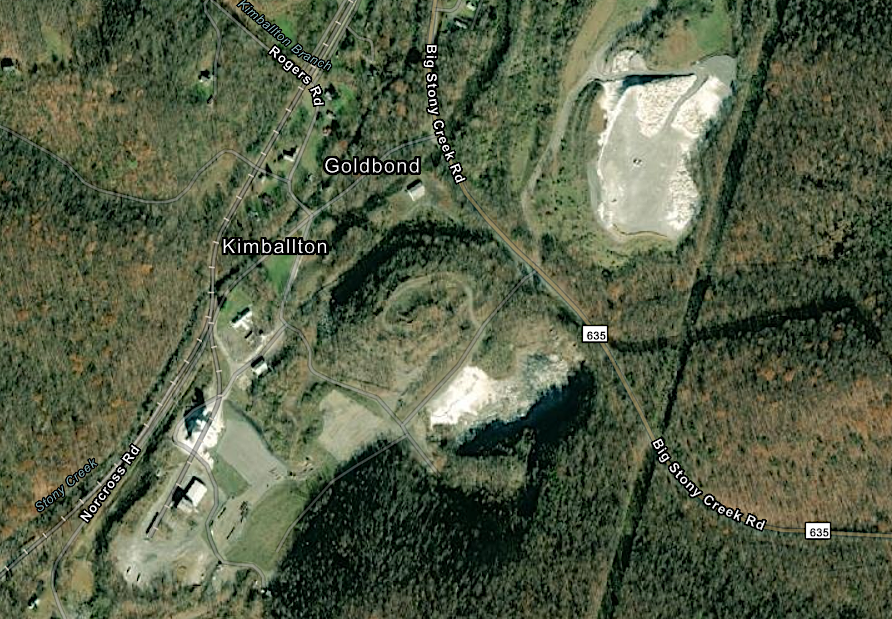
the Kimballton mine in Giles County is underground, with kilns which burn the limestone visible on the surface
Source: ESRI, ArcGIS Online
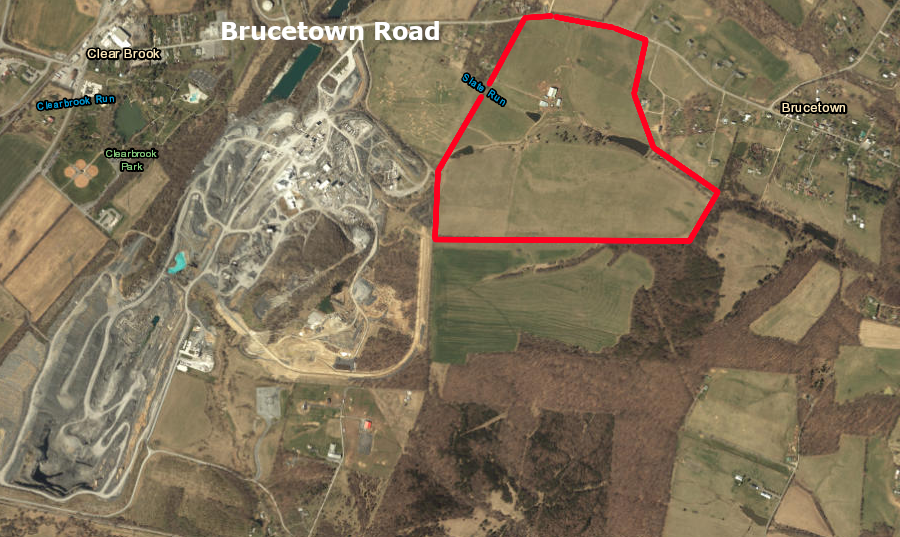
the Clorox cat litter plant would have been located on 146 acres (red polygon) near the Carmeuse quarry in Frederick County
Source: ESRI, ArcGIS Online
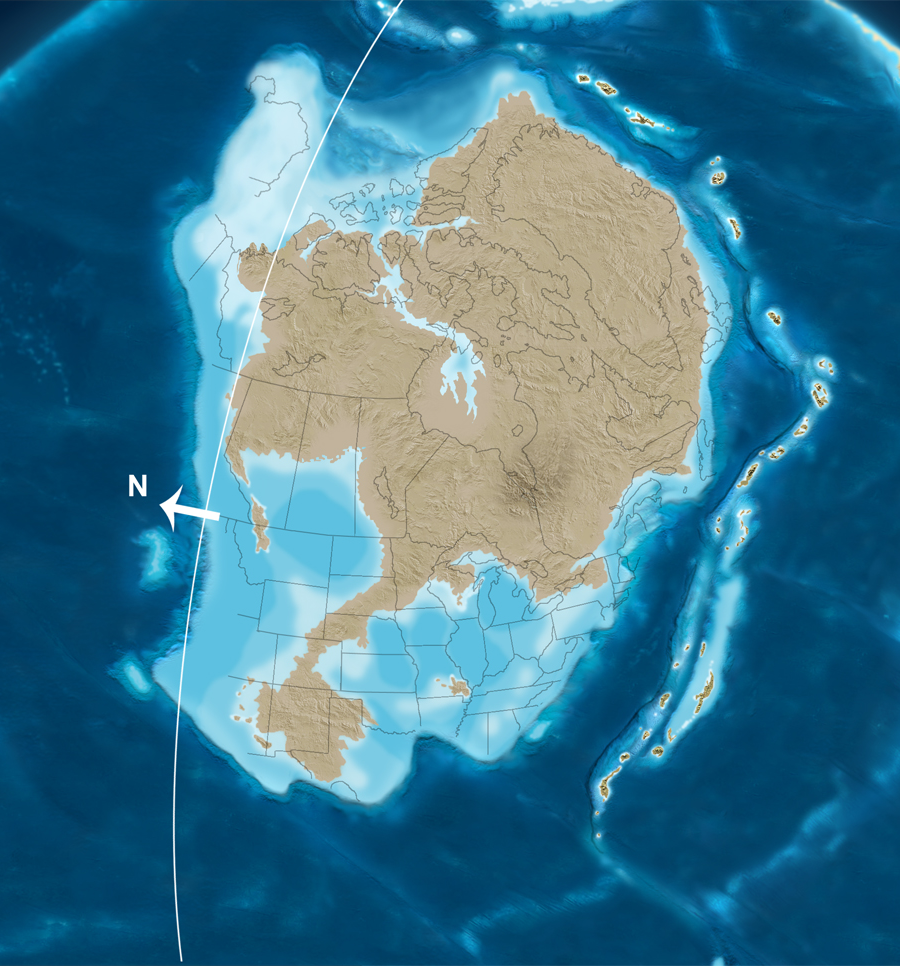
in the Cambrian Period, the limestones of the Valley and Ridge physiographic province were deposited in a shallow Iapetus Ocean
Source: Dr. Ron Blakey, Paleogeography and Geologic History of North America
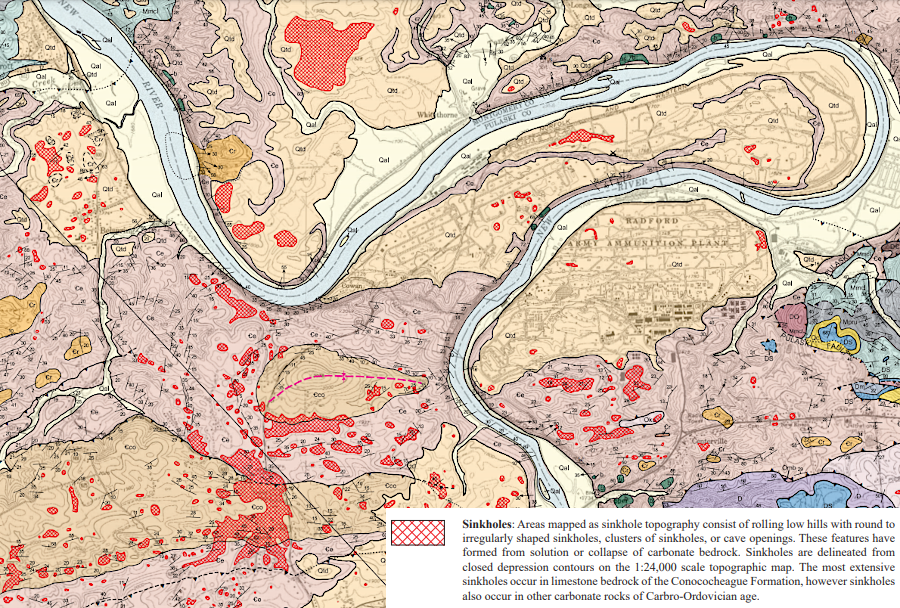
columns of Potomac Marble flank the old statue of Robert E. Lee in Statuary Hall
Source: Ken Lund, Robert E. Lee, National Statuary Hall (2008)